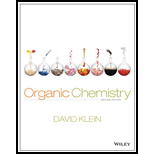
Organic Chemistry
2nd Edition
ISBN: 9781118452288
Author: David R. Klein
Publisher: WILEY
expand_more
expand_more
format_list_bulleted
Question
Chapter 18.4, Problem 6CC
Interpretation Introduction
Interpretation: For the given reaction, the structures should be drawn for the compound A and B with molecular formula
Concept introduction:
To draw the chemical structure the degree of unsaturation formula is used.
The formula gives the information about the number of rings, double bonds and triple bonds present in the compound.
Expert Solution & Answer
Want to see the full answer?
Check out a sample textbook solution
Students have asked these similar questions
Indicate how to obtain 2-metilbencimidazol from 1,2-diaminobenzene.
break down both reactions shown and explain it correctly using the bromonium ion mechanism, instead of the (disproven) carbocation-based mechanism.
Indicate how from 1,2-diaminobenzene to obtain 1-metilbenzotriazol.
Chapter 18 Solutions
Organic Chemistry
Ch. 18.2 - Prob. 1LTSCh. 18.2 - Prob. 1PTSCh. 18.2 - Prob. 2ATSCh. 18.2 - Prob. 3ATSCh. 18.2 - Prob. 4ATSCh. 18.2 - Prob. 5ATSCh. 18.4 - Prob. 6CCCh. 18.4 - Prob. 8CCCh. 18.4 - Prob. 9CCCh. 18.5 - Prob. 10CC
Ch. 18.5 - Prob. 2LTSCh. 18.5 - Prob. 11PTSCh. 18.5 - Prob. 12ATSCh. 18.5 - Prob. 13ATSCh. 18.5 - Prob. 14ATSCh. 18.5 - Prob. 3LTSCh. 18.5 - Prob. 15PTSCh. 18.5 - Prob. 16ATSCh. 18.5 - Prob. 17ATSCh. 18.5 - Prob. 18CCCh. 18.6 - Prob. 19CCCh. 18.6 - Prob. 4LTSCh. 18.6 - Prob. 20PTSCh. 18.6 - Prob. 21ATSCh. 18.6 - Prob. 22ATSCh. 18.6 - Prob. 23ATSCh. 18.7 - Prob. 5LTSCh. 18.7 - Prob. 24PTSCh. 18.7 - Prob. 25ATSCh. 18.8 - Prob. 26CCCh. 18.8 - Prob. 27CCCh. 18 - Prob. 28PPCh. 18 - Prob. 29PPCh. 18 - Prob. 30PPCh. 18 - Prob. 31PPCh. 18 - Prob. 32PPCh. 18 - Prob. 33PPCh. 18 - Prob. 34PPCh. 18 - Prob. 35PPCh. 18 - Prob. 36PPCh. 18 - Prob. 37PPCh. 18 - Prob. 38PPCh. 18 - Prob. 39PPCh. 18 - Prob. 40PPCh. 18 - Prob. 41PPCh. 18 - Prob. 42PPCh. 18 - Prob. 43PPCh. 18 - Prob. 44PPCh. 18 - Prob. 45PPCh. 18 - Prob. 46PPCh. 18 - Prob. 47PPCh. 18 - Prob. 48PPCh. 18 - Prob. 49PPCh. 18 - Prob. 50PPCh. 18 - Prob. 51PPCh. 18 - Prob. 52PPCh. 18 - Prob. 53IPCh. 18 - Prob. 54IPCh. 18 - Prob. 55IPCh. 18 - Prob. 56IPCh. 18 - Prob. 57IPCh. 18 - Prob. 58IPCh. 18 - Prob. 59IPCh. 18 - Prob. 60IPCh. 18 - Prob. 61IPCh. 18 - Prob. 62IPCh. 18 - Prob. 63IPCh. 18 - Prob. 64IPCh. 18 - Prob. 65IPCh. 18 - Prob. 66IPCh. 18 - Prob. 67IP
Knowledge Booster
Similar questions
- -C = C - C - + Br₂ + I" -> -C-C-c -C = C -C- + Br² + I₂ -C=C Br I + Brū + Iz -7- C - C-C- I Br Mechanism; - C = c - c - + Br - Br > - C-c-c- Br -C-C-C- + 1 - - -Ċ-Ċ'-c' - Br Br Iarrow_forwardWrite the mechanism of the esterification reaction (please show the mechanism included line pairs and arrows)arrow_forwardHow do I break down the reaction shown on the chalkboard and explain it correctly using the bromonium ion mechanism, instead of the (disproven) carbocation-based mechanismarrow_forward
- ¿Qué the product is obtained from tetraethoxypropano and hidrazina?. Indicate the reason why the corresponding dial is used.arrow_forwardIf CH3COCH2CH(OCH3)2 is reacted with hydrazine, two isomeric products are formed. Indicate their structures and the major product.arrow_forwardIs it possible to obtain addition derivatives to nitrogen in position 2 of pyrazoles by reaction with electrophilic agents? Reason for this.arrow_forward
- Starting from 1,3-dicarbonyl derivatives to obtain isooxazoles and isothiazoles. Indicate whether synthetic methods exist.arrow_forwardIn the synthesis of benzotriazole, adding NaNO2 heats the solution. State the reason.arrow_forwardIndicate the products obtained by treating benzotriazole with dimethyl sulfate or methyl iodide in a basic medium.arrow_forward
arrow_back_ios
SEE MORE QUESTIONS
arrow_forward_ios
Recommended textbooks for you
 ChemistryChemistryISBN:9781305957404Author:Steven S. Zumdahl, Susan A. Zumdahl, Donald J. DeCostePublisher:Cengage Learning
ChemistryChemistryISBN:9781305957404Author:Steven S. Zumdahl, Susan A. Zumdahl, Donald J. DeCostePublisher:Cengage Learning ChemistryChemistryISBN:9781259911156Author:Raymond Chang Dr., Jason Overby ProfessorPublisher:McGraw-Hill Education
ChemistryChemistryISBN:9781259911156Author:Raymond Chang Dr., Jason Overby ProfessorPublisher:McGraw-Hill Education Principles of Instrumental AnalysisChemistryISBN:9781305577213Author:Douglas A. Skoog, F. James Holler, Stanley R. CrouchPublisher:Cengage Learning
Principles of Instrumental AnalysisChemistryISBN:9781305577213Author:Douglas A. Skoog, F. James Holler, Stanley R. CrouchPublisher:Cengage Learning Organic ChemistryChemistryISBN:9780078021558Author:Janice Gorzynski Smith Dr.Publisher:McGraw-Hill Education
Organic ChemistryChemistryISBN:9780078021558Author:Janice Gorzynski Smith Dr.Publisher:McGraw-Hill Education Chemistry: Principles and ReactionsChemistryISBN:9781305079373Author:William L. Masterton, Cecile N. HurleyPublisher:Cengage Learning
Chemistry: Principles and ReactionsChemistryISBN:9781305079373Author:William L. Masterton, Cecile N. HurleyPublisher:Cengage Learning Elementary Principles of Chemical Processes, Bind...ChemistryISBN:9781118431221Author:Richard M. Felder, Ronald W. Rousseau, Lisa G. BullardPublisher:WILEY
Elementary Principles of Chemical Processes, Bind...ChemistryISBN:9781118431221Author:Richard M. Felder, Ronald W. Rousseau, Lisa G. BullardPublisher:WILEY

Chemistry
Chemistry
ISBN:9781305957404
Author:Steven S. Zumdahl, Susan A. Zumdahl, Donald J. DeCoste
Publisher:Cengage Learning

Chemistry
Chemistry
ISBN:9781259911156
Author:Raymond Chang Dr., Jason Overby Professor
Publisher:McGraw-Hill Education

Principles of Instrumental Analysis
Chemistry
ISBN:9781305577213
Author:Douglas A. Skoog, F. James Holler, Stanley R. Crouch
Publisher:Cengage Learning

Organic Chemistry
Chemistry
ISBN:9780078021558
Author:Janice Gorzynski Smith Dr.
Publisher:McGraw-Hill Education

Chemistry: Principles and Reactions
Chemistry
ISBN:9781305079373
Author:William L. Masterton, Cecile N. Hurley
Publisher:Cengage Learning

Elementary Principles of Chemical Processes, Bind...
Chemistry
ISBN:9781118431221
Author:Richard M. Felder, Ronald W. Rousseau, Lisa G. Bullard
Publisher:WILEY